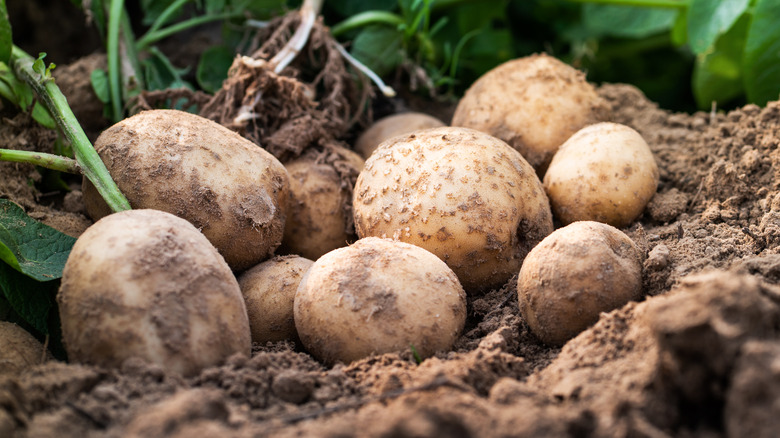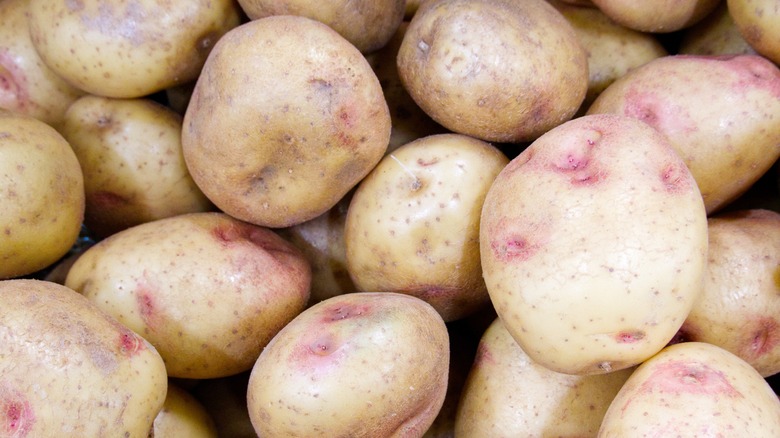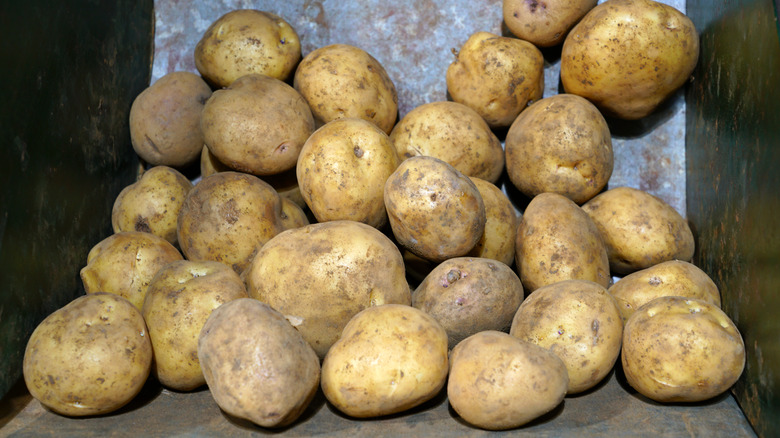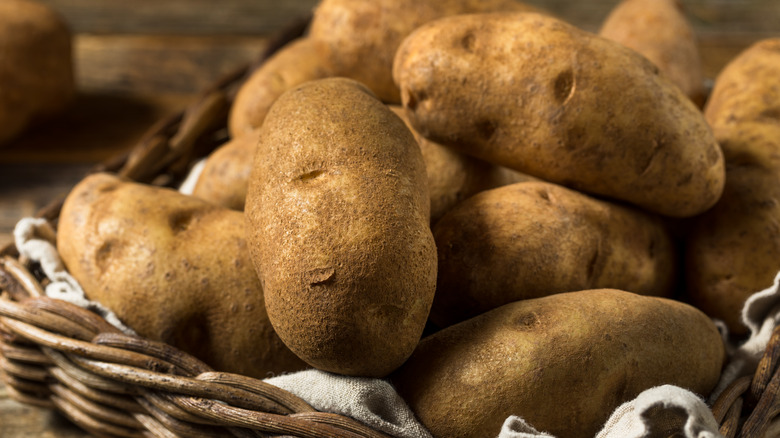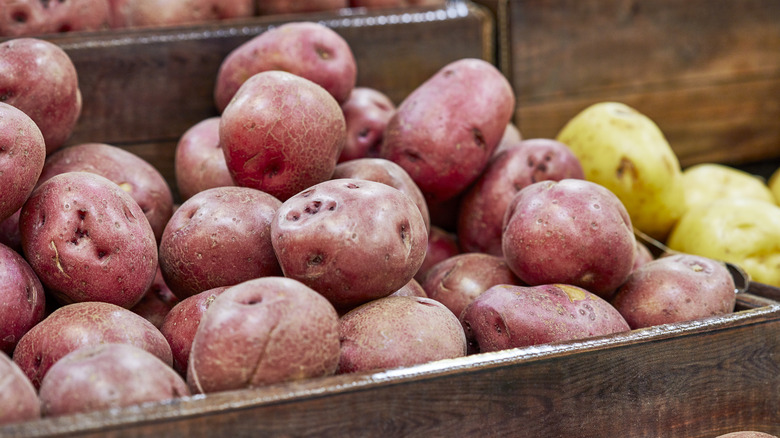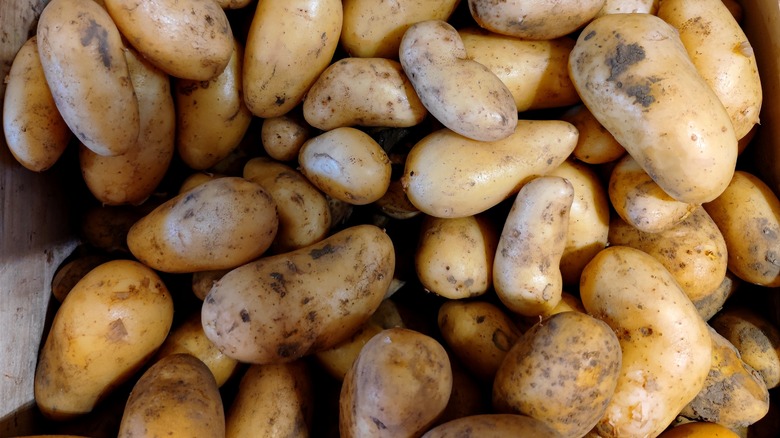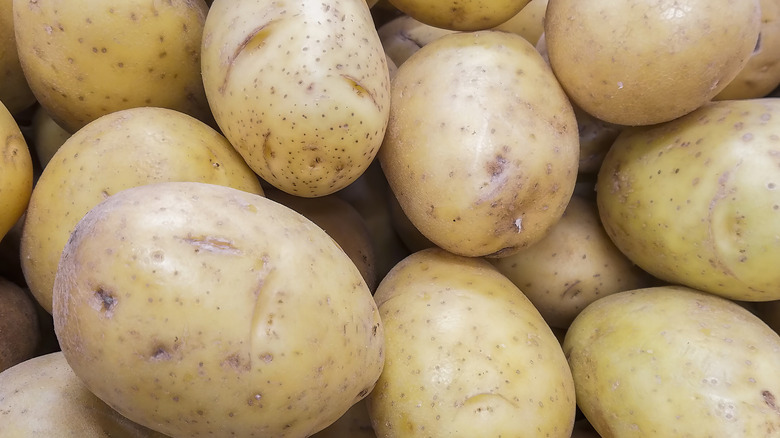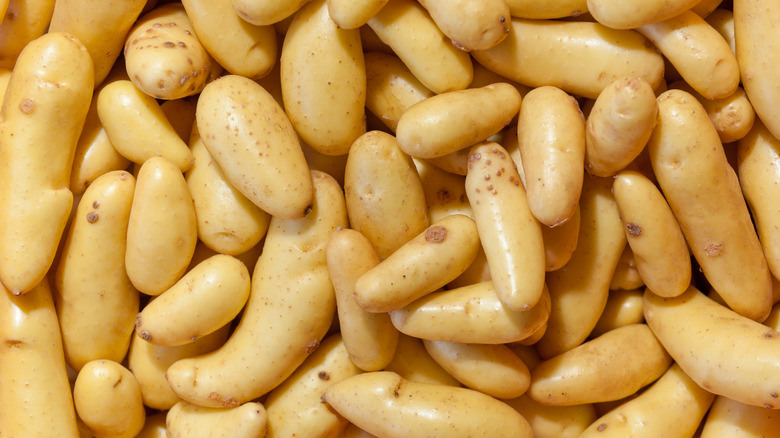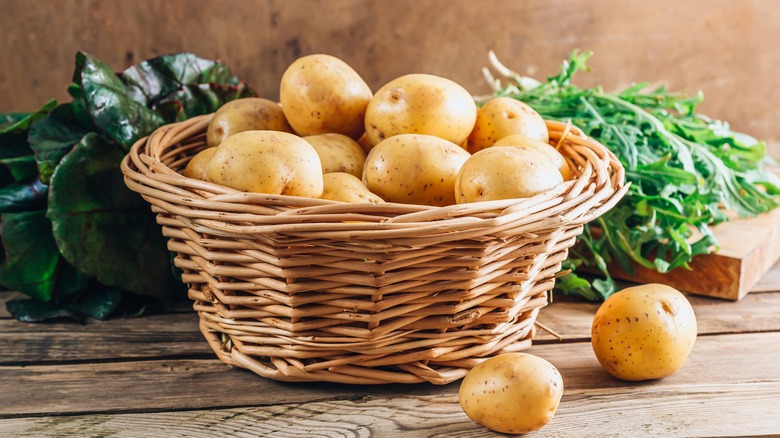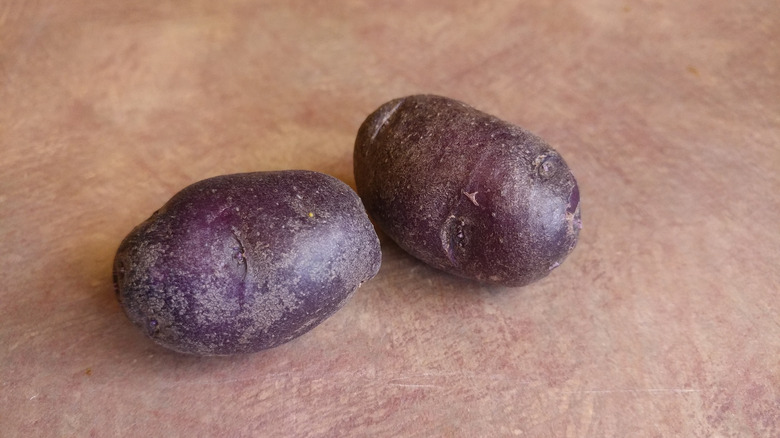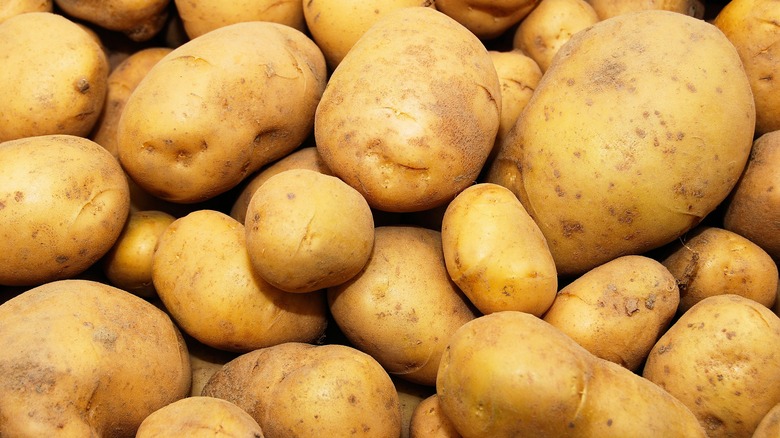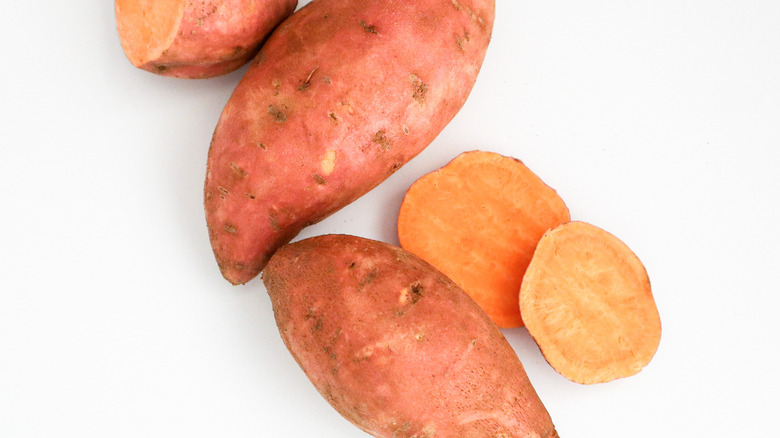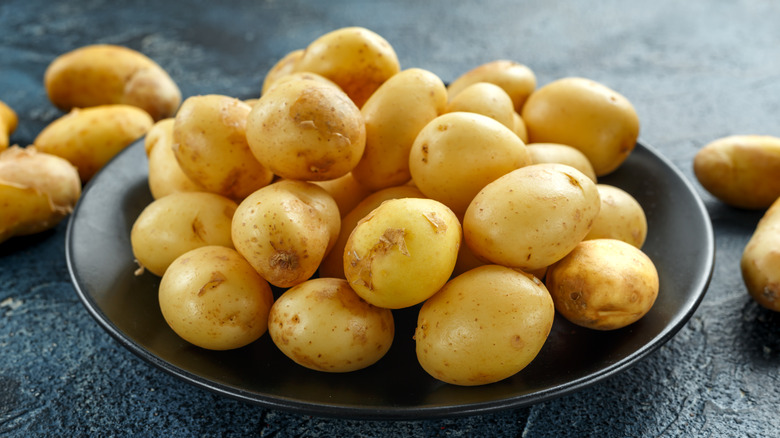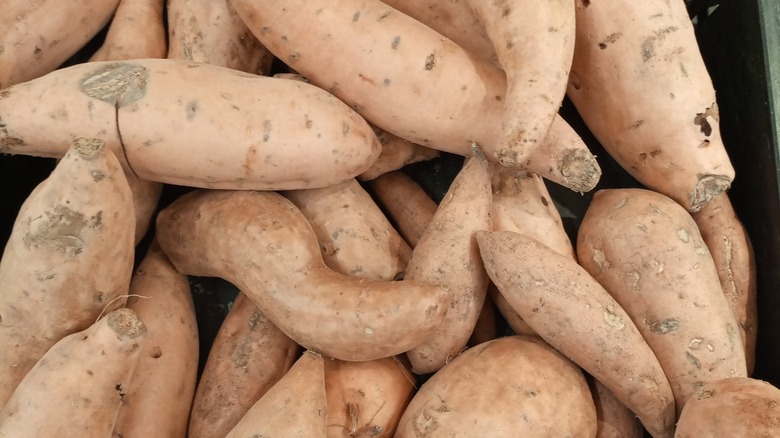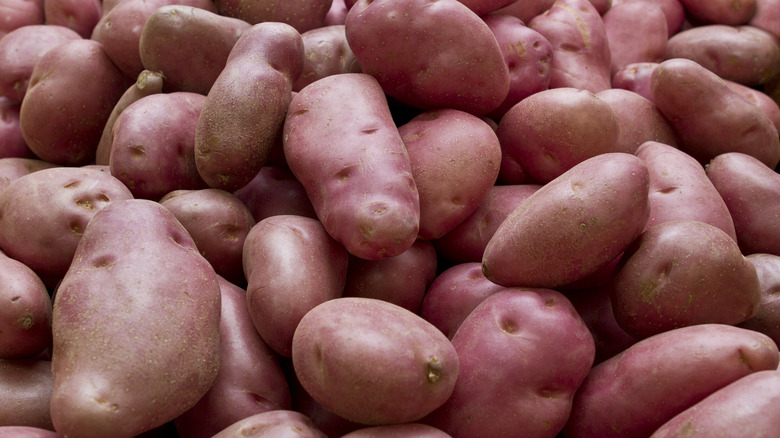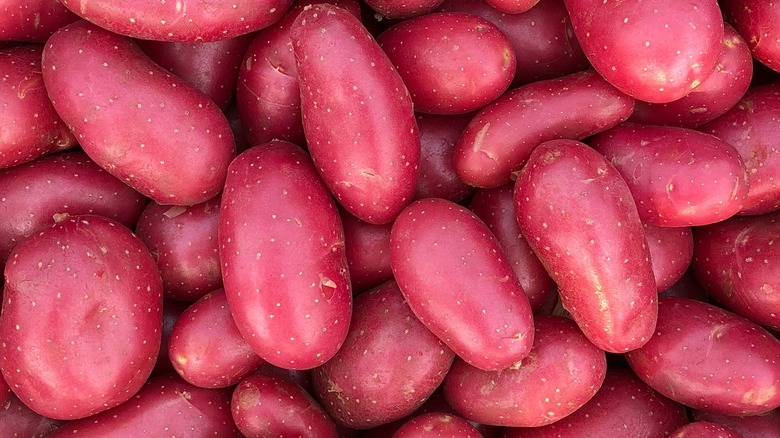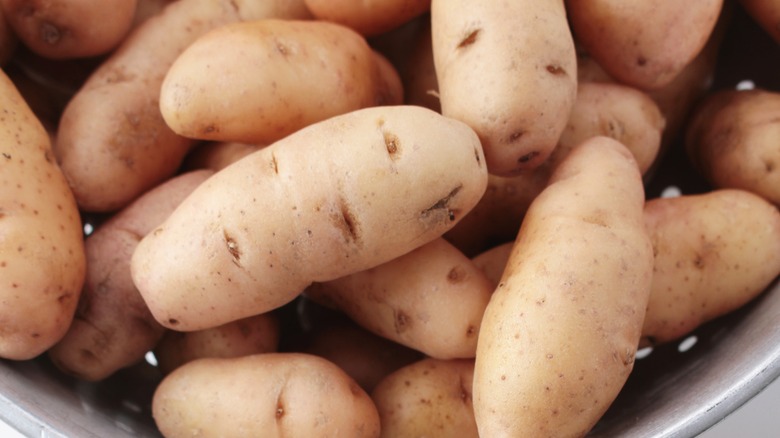The Ultimate Guide To Different Potato Varieties
It's hard to think of a more fundamental food than the potato. Like wheat and rice, potatoes are staple carbohydrates, and they've kept humankind fed and satisfied for over 8,000 years. Originally cultivated in South America, potatoes eventually spread across the globe, ending up on plates in virtually every country in the world. Nowadays, potatoes are present in a dizzying array of dishes and combinations, from being enjoyed on their own to being made into easy sides like potato au gratin, hash browns, potato salad, and mashed potatoes. There's not much the potato can't do.
But, perhaps because it's such a ubiquitous foodstuff, it's easy to forget that not all potatoes are the same. In truth, there's an incredibly wide variety of potatoes out there. Generally classified by the quality of their flesh, potatoes are determined as being starchy, waxy, or all purpose. And within those classifications is a wide range of flavors, sweetness levels, growing times, and uses. As such, it's easy to pick the wrong potato for your purposes — but not anymore. With our ultimate guide to different potatoes, you'll be an expert on this tremendous tuber and sure that you're picking the right potato for your meal every time.
King Edward potatoes
For those that like their potatoes with a royal flair, the King Edward is up there with the best. These year-round potatoes are about as classic as they get and generally have a light brown skin and creamy flesh. King Edward potatoes are particularly popular in the United Kingdom, cultivated there since the start of the 20th century. Named in honor of King Edward VII's coronation, these potatoes are hearty and nutritious, containing vitamins B6 and C and potassium in good quantities.
Where the King Edward shines is in its versatility. The large potato is excellent for mashing, thanks to its fluffy consistency, and is especially good roasted. King Edwards also make superb fondant potatoes. They're especially suited to this cooking style thanks to their ability to develop a good browning on the outside while remaining pillowy and soft in their interior. King Edward potatoes are also pretty easy to cultivate at home, so the gardeners out there would do well to get themselves a pack of seeds for this variant. Once bought or harvested, King Edwards will generally last for several weeks before they start to spoil if kept somewhere cool and dark.
Dutch cream
The Dutch cream has more going for it than just a pleasant-sounding name. This waxy potato is a must for anyone who likes their potatoes on the richer side. Dutch creams have an especially buttery flavor, a sturdy construction, and a yellow hue, making them an appealing choice for a range of uses. Thanks to their waxy nature, they tend not to fall apart easily, so they're great for cutting into smaller pieces, like for french fries.
Dutch creams are also particularly good simply boiled and served up on a plate, thanks to the richness of their flesh. This potato generally tends to flourish later in the season and grows best in full sunlight. As an indeterminate potato variety, they can take a little longer to grow than some other types. If you're planting them in your garden, you should give them approximately three to four months to grow to their full potential. Generally, you should try to harvest them by 130 days into their growth.
Russet
Think of potatoes, and the image that comes to mind is likely of the russet variety. This quintessential potato is an American classic, originally developed in the late 19th century in Massachusetts. Nowadays, the russet potato is the most common in the U.S. and can be found year-round.
These potatoes generally have a slightly darker, rough skin, with an off-white, floury flesh. As with other potatoes, they're high in vitamins C and B6 and have good magnesium levels. They're also great sources of fiber, especially when cooked with the skin on. You can do pretty much anything with russet potatoes, but they're particularly good when fried. Slice them up and fry them in rounds, turn them into french fries, or shred them into hash browns to enjoy them at their very best. Alternatively, russet potatoes can be used for mashing, roasting, or serving up boiled. These potatoes have a fairly long shelf life and, once bought, will usually keep for roughly a month when stored out of direct sunlight. Before using, though, always scan your russet potatoes for any signs of spoilage, discoloration, softness, or bruising.
Red potatoes
If you want your potatoes to be a little more eye-catching, red potatoes are where it's at. Red potatoes are immediately noticeable for their vivid red skin, which can add a visual flair both to your pantry and your food. Red potatoes are generally smaller than some other varieties and usually have a gentle, oblong shape. Despite their bright red skin, the inside of a red potato is white.
The flesh of the red potato is of the waxy variety, and because of this, they have a robustness that some other, more floury potatoes can lack. As such, red potatoes are best used when your carb needs a little bite to it. They stand up especially well in potato salads, where they don't disintegrate as readily as starchier varieties, and make satisfying chunks in stews and soups. Red potatoes can tend to taste a little sweeter than some other potato types, although this isn't overpowering. They're a particularly good source of potassium, too. Our top tip when it comes to red potatoes is to use them in recipes where you know you won't have to peel the potato. The joy of using this variety comes largely from its visual impact, so embrace it!
Kipfler
Although we tend to think of potatoes as pleasingly fat and round, that's not always the case, and kipfler potatoes are a good example of this. Kipflers are notable for their longer, almost cigar-like shape, with a brownish skin that gives way to yellow flesh. A waxy potato, the kipfler has a slightly nutty edge to its taste and retains its structure well.
You're more likely to find kipfler potatoes across parts of western and central Europe, but they also show up in some stores across the United States. They're also particularly popular in Australia. Thanks to their hardy nature, kipfler potatoes are great for roasting. Where you're better off not using them, though, is in mashed potatoes. Their waxy flesh may prove a little too tough to make a satisfying, fluffy mash, and you're far better off employing them when you want some bite to your carb.
These potatoes are year-round staples, and in addition to having good vitamin C and potassium levels, they're also a good source of manganese and copper. Like other potatoes, kipfler potatoes can keep for a good few weeks before they start to go bad.
Yukon Gold
The Yukon Gold is one of the most reliable potatoes out there. These potatoes are exceedingly popular, with a serious versatility, as at home cut into french fries as they are baked. Yukon Golds are generally medium sized, with gentle brown skin and light yellow flesh. They have a particularly rich taste and a creaminess that puts them in contrast with other slightly sharper, sweeter potatoes.
Yukon Golds are also exceedingly easy to grow and come into full maturity very quickly. At their peak in the spring and fall, they take well to cooler conditions. They can generally be out of the ground and onto your plate in up to 80 days in warmer seasons, and 90 days in colder ones. Of all the uses for Yukon Golds, though, mashed potatoes might be the best. The reason you should be using Yukon Golds for mashed potatoes is down to not just their taste but also their starchiness. Their fluffy nature means that they transform into a pile of glorious mash with ease, and you can keep the skin on or take it off — whichever you prefer. Crush them up and add in a few pats of butter to complement the already creamy taste, and you'll be in heaven.
Russian banana
The Russian banana is a potato that's not just notable for its unique name. These uniquely shaped potatoes are part of the fingerling family, cultivars known for their finger-like, oblong shape. Usually growing to around 4 inches long, they have a gentle curve to them and feature light brown skin with pale flesh.
Thanks to their unique, slim shape, fingerling potatoes are great for serving whole or sliced into smaller rounds. Russian bananas particularly shine when they're roasted, but like other potatoes, they can also be fried, baked, or boiled. They're also terrific when incorporated into a meal like a potato salad.
These potatoes generally come into their own later into the season and are best harvested towards the end of the summer. If you're growing them at home, though, be aware that Russian bananas don't thrive in hotter temperatures. If you live in an area that routinely reaches temperatures over 80 degrees Fahrenheit in the summer, you might want to shift your planting to later in the year. That way, you can harvest them at the start of spring.
New potatoes
While we typically think of potatoes as large, new potatoes are little portions of joy. Smaller tubers that are harvested early, new potatoes pack a lot of punch into every bite. They generally have a thin, tender skin, which covers a fairly robust flesh that has a good snap to it. These waxy potatoes can have a bit of a crisper flavor than regular potatoes, with a sweetness to them.
Given their small size, these potatoes are best enjoyed whole, or potentially halved if they're slightly bigger. They're generally best either roasted or boiled, which allows them to retain their shape while becoming soft and tender to eat. There's no need to remove the skin of new potatoes, either. As well as just being too fiddly to peel, their skin is so thin that getting rid of it doesn't significantly alter the potatoes' taste or texture that much. A spring-summer tuber, new potatoes are usually taken from the ground at the start of the harvest, before they have a chance to grow into their full form. Bear in mind, though, that they can deteriorate faster than larger potatoes. They're best eaten fresh, and not kept for too long.
Purple majesty
One of the best things about potatoes is their variability. Contrary to the popular depiction of stout, fat, brown potatoes, they can come in all different shapes, sizes, and even colors. Purple majesty potatoes are a great example of this. These potatoes have rich purple flesh, encased in similarly dark purple skin. Although they're more striking than regular potatoes, they grow in much the same fashion, taking roughly three months to reach full harvest.
But while they're notable for their visual appeal, that doesn't mean you should write off their taste. These potatoes have a nice sweetness to them and are best used in situations that allow their color to take center stage. Using purple majesty potatoes in a salad, for example, will give your food a rich and distinctive tone. Making fries out of purple majesties, on the other hand, provides an exciting alternative to regular potatoes. They also tend to stay just as vibrant after cooking, so you won't have to worry about them fading.
Nutritionally, too, these potatoes are next level. They're especially high in antioxidants, thanks to the pigments that turn them such a deep purple. They also contain really good vitamin C levels.
Kennebec
Kennebec potatoes are as reliable as they come. A starchy cultivar, Kennebecs have a classic potato look, with a light brown, almost beige skin and pale flesh. These potatoes are particularly well known for their use by food companies as the superlative variety for chips and fries. Thanks to their ability to not warp or break considerably upon cooking, they tend to be very well suited for chopping into smaller pieces and frying.
The Kennebec variety is also great for mashing, thanks to its starchy texture, and roasts into a potato with a soft, pillowy interior. It has a particularly nutty taste, thanks to it being slightly lower in sugar and higher in starch. Kennebec potatoes are widely available and can be found at any point in the year. These potatoes are also particularly nutritious, with a wide range of vitamins and minerals residing in the tubers' flesh and skin. Along with a host of B vitamins, like riboflavin, thiamin, and niacin, there's also vitamin C, potassium, and some all-important fiber.
Sweet potatoes
Could we talk about potatoes without mentioning the sweetest ones of all? Sweet potatoes may stand slightly apart from regular potatoes, thanks to their orange flesh and sugary taste, but they're potatoes in their own right. When fully grown, these potatoes have a medium-brown skin and a vibrant orange interior that fluffs up nicely when cooked. They're as versatile as regular potatoes, too, and can be baked in the oven, fried, roasted, mashed, or put in the air fryer.
While it's a common practice to remove the skin of a sweet potato, it's important to remember that it's both edible and nutritious. The rest of the potato is nutritious, too, and has a robust vitamin and mineral content, particularly vitamin D and iron. They also have a good amount of protein. Sweet potatoes can take a little longer to come to full maturity than other potatoes, and generally take four months, or even up to 150 days, to be harvestable. They usually grow best in warm weather and fairly moist soil that's not too damp or waterlogged.
Petite potatoes
Regular potatoes are pretty cute in their own right. But if you're looking for a way to make your potatoes even more adorable, getting them in a smaller size is a surefire winner. Petite potatoes are pretty much the smallest potatoes out there, similar in appearance to normal potatoes but often no bigger than the size of a marble. That doesn't mean you should underestimate them, though. Their taste is particularly pronounced, thanks to the fact that the sugar and starch that you get in a regular potato is concentrated into a smaller size.
Petite potatoes can also be found labeled as "baby potatoes" or "pearlers" and can vary in color, coming in brown, beige, red, and purple. Thanks to their bite-size nature, petite potatoes are often served whole and are best used as part of a dish where they can shine. Aside from potato salad, using petite potatoes in meals like traybakes, or even roasted on their own, is a great way to serve them up. Slicing them into thins and roasting or frying them is also an exciting way to get them on a plate.
Hannah sweet potatoes
A vision in pastel, Hannah sweet potatoes are as good looking as they are good tasting. This sweet potato has a lighter flesh than the regular orange tones you might expect, as well as a gentle brown, almost pinkish skin. Available at any time of the year, Hannah sweet potatoes also have a flavor that's somewhat between a regular potato and a sweet potato. When cooked, they become pretty starchy, while retaining the sweetness that gives them their name, and can be prepared in many ways.
One thing to watch out for with Hannah sweet potatoes is discoloration once they're sliced open. When they come into contact with oxygen, they will start to change color and brown, so it's useful to prepare them just before cooking. The good news, though, is that Hannah sweet potatoes go with pretty much everything, and whether you're using them in savory or sweet dishes, they slot in perfectly. Hannahs tend to deteriorate a little faster than other sweet potatoes or potatoes, but they'll usually last for a few weeks before they start to go bad, as long as they're kept out of direct sunlight.
Desiree
If it's a solid potato you desire, grab yourself a Desiree. A particularly visually appealing tuber, the Desiree generally has brown-red skin and super-bright, creamy flesh. When left to grow properly, they can reach pretty large sizes. A fairly modern cultivar, Desiree potatoes were first grown in Holland in the mid-20th century and are now commonly found across Europe and in the United Kingdom.
As with other potatoes, Desiree potatoes are particularly versatile and can be used for pretty much anything. Try slicing them up into fries or wedges, mashing them into a pile of buttery goodness, or boiling them for a simple accompaniment to other foods. They have a certain robustness that other potatoes lack when cooked, so they're also pretty good for use in liquid-based dishes like soups and stews. One cooking style they're not especially well suited for, however, is potato salad, with other potato varieties better for use in cold dishes. They're also not a natural fit for steaming.
Red thumb
Red thumb potatoes provide an aesthetic pop to your plate. Like purple majesty potatoes, red thumb potatoes provide a vast contrast to your classic white- or cream-colored variety, with reddish-brown skin and deep pink flesh. A fingerling cultivar, red thumb potatoes are generally cylindrical or oblong, sometimes with a crescent curve to them. They're also fairly hardy and are able to grow in both cool and warm conditions. Red thumbs come to their full potential fairly quickly and can be harvested after 90 days. It's advisable, though, to give them roughly 110 days if you want them to grow larger. They can also be grown year-round.
A must for amateur gardeners, red thumb potatoes are pretty easy to care for, and the average crop will produce a good amount of tubers to enjoy. These potatoes can be enjoyed in a variety of ways and have a lovely, pronounced flavor. As such, you'll likely not want to drown them in dressings or other elements in order to let the potatoes shine, both for their color and for their taste. Red thumbs are great roasted on their own or baked. If you are using them in a potato salad, they'll provide a pretty dramatic visual element to your dish.
Pink fir apple
Pink fir apple potatoes may not be the most beautiful potatoes in the bunch, but you can't fault them for their culinary excellence. When fully grown, pink fir apples generally become pretty knobby and look a little like large fingerling potatoes. Their natural shape makes them a great choice for slicing into rounds, although they can come out of the ground in a variety of permutations. Essentially, expect the unexpected with a pink fir apple.
These potatoes generally have a light brown skin that can blush pink in places and, when sliced open, have pale flesh. The skin is a little bit thicker than some other potato varieties, but if you choose to eat it, it poses no problems whatsoever. While pink fir apples may not be especially majestic-looking, they're incredibly hardy and can last for a few months once pulled out of the ground. They have fairly waxy flesh and, as such, can hold their shape pretty well. This makes them a great choice for using in potato salads, where they won't fall apart once you add in dressings and other elements.
